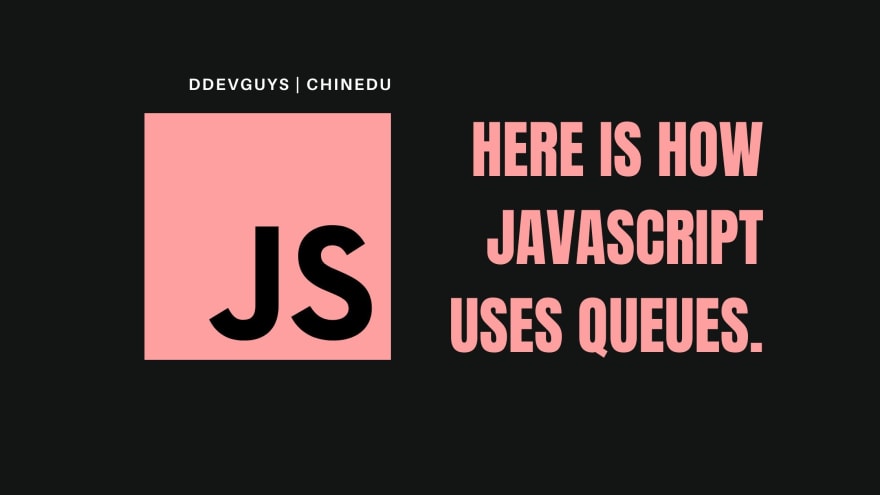An Interest In:
Web News this Week
- April 4, 2024
- April 3, 2024
- April 2, 2024
- April 1, 2024
- March 31, 2024
- March 30, 2024
- March 29, 2024
Javascript: How to implement a queue
After, writing about STACKS, the positive feedback, and all the support and nice DMs I got on Instagram and Twitter has made me turn this into a series, yeah you read that right.
This is going to be a series of data-structures and algorithms using javascript.
I hope you reading this enjoys it. Lets go
In todays blog article, we would be talking about queues!
What is a queue A queue is a data structure that follows the first in first out (FIFO)principle.
Example: people standing in a line (first come first serve) to get groceries from a grocery store, etc.
Queues are very similar to stack, but instead of using the LIFO principles like stacks do they use the FIFO principle which we would implement as we go on.
In javascript, we have array methods that define the queue class which is a push() and shift() method.
Adding an item to the queue is commonly known as enqueuing and removing an item from the queue is known as dequeuing.
push() is used to enqueue while shift() is used to dequeue.
The shift() is a javascript array method that removes and returns the first element of an array.
Lets create a queue
Lets write some codes, shall we? As usual, we start with the basics and declare a class using an array in the constructor property of our class.
// Queue classClass Queue{ constructor() { this.items=[]; } //Methods to be implemented go here enqueue(item) dequeue() front() isEmpty() size() print()}Lets implement each method for our queue class.
Enqueue: This adds a new item to the back of the queue, this is similar to standing in a line (queue) to get items from a grocery store.
enqueue(item) {//enqueuing items onto the queuethis.items.push(item)}Dequeue: This removes and returns the first item on the queue, this is the first come first serve.
The first person to get to our imaginary grocery store is the first person to be attended to.
dequeue(){//remove items from the queuethis.items.shift()}Front: This method returns the first item from the queue, but it does not modify the queue.
In our imaginary grocery store, lets imagine that the grocery store attendant wants to know who is first on the queue.
Note that he has not attended to this person yet in our case has not modified the queue.
He just wants to know who is first on the queue.
front() {//returns the first item on the queuethis.items[0]}isEmpty: This returns false if the queue contains items or is greater than 0, and returns true if the queue is empty.
In our imaginary grocery store, lets imagine that the grocery store attendant wants to know if there are more customers to attend to, if there are customers, that means the queue is not empty so as a result, we get false.
But if the grocery attendant has attended to everyone in the queue, then that means the queue is empty so as a result, we get true
isEmpty() {this.items.length == 0;}Size: This gives us the number of items in our queue.
Back to our imaginary grocery store where we have a queue of customers.
Lets imagine that the grocery store attendant for some reasons best known to him wants to know how many people he is attending to at the moment (people on the queue) then he will have to count them right? Yeah.
size() {//check the number of items on the queuethis.items.length;}Just like when we implemented the STACKS class. We could go a step further to add a print method to help us print all the items in the queue whenever we want.
print() {//log all the items in the queueconsole.log(items to String())}Lets use the queue class First, we have to instantiate the queue class we created
//instantiating the queuelet queue = new Queue()Next, we can add items to our queue (since we are using the imaginary grocery store queue we would use real peoples names and enqueue them unto our queue. Let's use Vivian, Gideon, and Shalom)
// pushing a new item (customers) to the queuequeue.enqueue("Vivian")queue.enqueue("Gideon")queue.enqueue("Shalom")Next, we can go ahead to check if items are on the queue (checking if anyone is on our grocery store queue)
//returns falseconsole.log(queue.isEmpty())Next, we call the front() method, by doing so we would get Vivian because she happens to be the first person in the queue.
//returns vivianqueue.front()Now, we want to check the size of our queue to see how many items (customers) are on it.
//returns 3Console.log(queue.size())Lets print out all the items in our queue
//returns [Vivian, Gideon, Shalom]queue.print()Lets remove items from the queue.
In our imaginary grocery store, we have to attend to our customers right? Yeah! If that be the case this has to happen in a first come first serve format (FIFO)).
Lets do this
//remove each item from the queuequeue.dequeue()queue.dequeue()if we run
queue.print()we see that Vivian and Gideon has left the queue (our first two customers have been tended too) so we have only shalom to attend too.
Lets not waste his time lets attend to him, so once again we run the dequeue method of our queue class
queue.dequeue ()To confirm our last action we can once again check if our queue is empty. This should return true
//returns truequeue.isEmpty()With this, we can say we have successfully implemented a queue in JavaScript KUDOS  you made it to this point but one more thing
you made it to this point but one more thing
Whenever a new tab is opened in a browser a task queue is created.
This is because of something we call the event loop and in the event loop only a single thread handles all the tasks for a single tab.
The browser handles several tasks such as handling user interaction (keyboard clicks, mouse clicks, etc), processing and executing async requests, executing javascript, and rendering HTML.
This is amazing that a very powerful and yet popular language like javascript uses queues to handle its internal control. You could learn more about it here
Once again as always thanks for being with me till the end.
Next, I would be writing about a very popular kind of queue implementation or maybe a linked list.
Well, I dont know which to write about if you could make that choice for me Id really appreciate you could consider sending a DM on Twitter or Instagram (join our 36k community members).
Cheers! Keep Grinding
Original Link: https://dev.to/chinedu/javascript-how-to-implement-a-queue-3e1c
Dev To
 An online community for sharing and discovering great ideas, having debates, and making friends
An online community for sharing and discovering great ideas, having debates, and making friendsMore About this Source Visit Dev To




